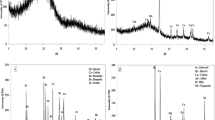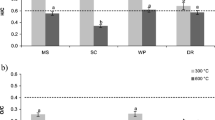Abstract
The efficiency of biochars (BCs) derived from paper mill sludge (PM-BC), distillery sludge (DS-BC), and pruned branches from roadside trees (PB-BC) for immobilization of selected heavy metals (Cd and Zn) in agricultural soils was examined in the current study. This examination was conducted in order to elucidate whether the recycling of organic wastes could be used as a management option for metal-contaminated agricultural soils. Biochars were applied to contaminated upland soil exceeding the guideline values for Cd (4 mg kg−1) and Zn (300 mg kg−1) in Korea. Both the incubation study and the pot trial with lettuce cultivation were carried out using soil-BCs mixtures at 0, 1, 2, and 5 % (w/w). From the incubation study, it appears that BCs incorporated into the soil induces an increasing soil pH and a significant decline (Cd 36 ~ 100 %; Zn 54 ~ 100 %) in the phytoavailable metal pool examined by 1 M NH4NO3 extraction. The PM-BC was most effective in the reduction of Cd and Zn phytoavailability, due to a significantly higher pH and surface area than the DS-BC and PB-BC. Similar results were observed in the pot trial, where the uptake of heavy metals by lettuce greatly declined with PM-BC incorporation (Cd 26 ~ 71 %; Zn 28 ~ 45 %). PM-BC enhanced the lettuce growth performance evidenced by the highest yield of lettuce being observed with PM-BC-treated soils at 5 %. This was attributed to retardation of the metal toxic effect induced by a decrease in Cd accumulation, while the increased nutrient elements originated from PM-BC. This present study indicates that paper mill sludge is a great candidate for biochar production that can be utilized as a soil amendment for metal-contaminated agricultural soils.






Similar content being viewed by others
References
Ahmad, M., Lee, S. S., Yang, J. E., Ro, H. M., Lee, Y. H., & Ok, Y. S. (2012). Effects of soil dilution and amendments (mussel shell, cow bone, and biochar) on Pb availability and phytotoxicity in military shooting range soil. Ecotoxicology and Environmental Safety, 79, 225–231.
Ahmad, M., Rajapaksha, A. U., Lim, J. E., Zhang, M., Bolan, N., Mohan, D., Vithanage, M., Lee, S. S., & Ok, Y. S. (2014). Biochar as a sorbent for contaminant management in soil and water: a review. Chemosphere, 99, 19–33.
Bian, R., Joseph, S., Cui, L., Pan, G., Li, L., Liu, X., Zhang, A., Rutlidge, H., Wong, S., Chia, C., Marjo, C., Gong, B., Munroe, P., & Donne, S. (2014). A three-year experiment confirms continuous immobilization of cadmium and lead in contaminated paddy field with biochar amendment. Journal of Hazardous Materials, 272, 121–128.
Bolan, N. S., Adriano, D. C., Mani, P. A., & Duraisamy, A. (2003). Immobilization and phytoavailability of cadmium in variable charge soils. II. Effect of lime addition. Plant and Soil, 251, 187–198.
CEN (Committee for European Normalization). (2011a). EN 13037:2011 Soil improvers and growing media - Determination of pH. Belgium: CEN (Committee for European Normalization).
CEN (Committee for European Normalization). (2011b). EN 13038:2011 Soil improvers and growing media - Determination of electrical conductivity. Belgium: CEN (Committee for European Normalization).
DIN 19730 (Deutches Institute für Normung). (1995). Soil quality extraction of trace elements with ammonium nitrate solution. Berlin: DIN 19730 (Deutches Institute für Normung).
Fellet, G., Marmiroli, M., & Marchiol, L. (2014). Elements uptake by metal accumulator species grown on mine tailings amended with three types of biochar. Science of the Total Environment, 468–469, 598–608.
Garau, G., Castaldi, P., Santona, L., Deiana, P., & Melis, P. (2007). Influence of red mud, zeolite and lime on heavy metal immobilization, culturable heterotrophic microbial populations and enzyme activities in a contaminated soil. Geoderma, 142, 47–57.
Gray, C. W., Dunham, S. J., Dennis, P. G., Zhao, F. J., & McGrath, S. P. (2006). Field evaluation of in situ remediation of a heavy metal contaminated soil using lime and red-mud. Environmental Pollution, 142, 530–539.
Houben, D., Evrard, L., & Sonnet, P. (2013a). Mobility, bioavailability and pH-dependent leaching of cadmium, zinc and lead in a contaminated soil amended with biochar. Chemosphere, 92, 1450–1457.
Houben, D., Evrard, L., & Sonnet, P. (2013b). Beneficial effects of biochar application to contaminated soils on the bioavailability of Cd, Pb and Zn and the biomass production of rapeseed (Brassica napus L.). Biomass and Bioenergy, 57, 196–204.
Khan, S., Chao, C., Waqas, M., Arp, H. P. H., & Zhu, Y. G. (2013). Sewage sludge biochar influence upon rice (Oryza sativa L) yield, metal bioaccumulation and greenhouse gas emissions from acidic paddy soil. Environmental Science & Technology, 47, 8624–8632.
Kim, K. R., Owens, G., & Kwon, S. I. (2010a). Influence of Indian mustard (Brassica juncea) on rhizosphere soil solution chemistry in long-term contaminated soils: a rhizobox study. Journal of Environmental Sciences, 22, 98–105.
Kim, K. R., Owens, G., & Naidu, R. (2010b). Effect of root-induced chemical changes on dynamics and plant uptake of heavy metals in rhizosphere soils. Pedosphere, 20, 494–504.
Korea Zero Waste Movement Network. (2010). Estimating of quantity of timber recycling resources. Seoul: Korea Zero Waste Movement Network.
Lee, S. S., Lim, J. E., El-Azeem, S. A. A., Choi, B., Oh, S. E., Moon, D. H., & Ok, Y. S. (2013). Heavy metal immobilization in soil near abandoned mines using eggshell waste and rapeseed residue. Environmental Science and Pollution Research, 20, 1719–1726.
Lehmann, J. (2007a). A handful of carbon. Nature, 447, 143–144.
Lehmann, J. (2007b). Bio-energy in the black. Frontiers in Ecology and the Environment, 5, 381–387.
Lehmann, J., Gaunt, J., & Rondon, M. (2006). Bio-char sequestration in terrestrial ecosystems—a review. Mitigation and Adaptation Strategies for Global Change, 11, 395–419.
Lehmann, J., Rillig, M. C., Thies, J., Masiello, C. A., Hockaday, W. C., & Crowley, D. (2011). Biochar effects on soil biota—a review. Soil Biology and Biochemistry, 43, 1812–1836.
Li, Z., Ma, Z., van der Kuijp, T. J., Yuan, Z., & Huang, L. (2014). A review of soil heavy metal pollution from mines in China: pollution and health risk assessment. Science of the Total Environment, 468, 843–853.
Lombi, E., Hamon, R. E., McGrath, S. P., & McLaughlin, M. J. (2003). Lability of Cd, Cu, and Zn in polluted soils treated with lime, beringite, and red mud and identification of a non-labile colloidal fraction of metals using isotopic techniques. Environmental Science & Technology, 37, 979–984.
Lu, K., Yang, X., Shen, J., Robinson, B., Huang, H., Liu, D., Bolan, N., Pei, J., & Wang, H. (2014). Effect of bamboo and rice straw biochars on the bioavailability of Cd, Cu, Pb and Zn to Sedum plumbizincicola. Agriculture, Ecosystems & Environment, 191, 124–132.
Mench, M., & Martin, E. (1991). Mobilization of cadmium and other metals from two soils by root exudates of Zea mays L., Nicotiana tabacum L. and Nicotiana rustica L. Plant and Soil, 132, 187–196.
Méndez, A., Gómez, A., Paz-Ferreiro, J., & Gascó, G. (2012). Effects of sewage sludge biochar on plant metal availability after application to a Mediterranean soil. Chemosphere, 89, 1354–1359.
Ministry of Environment. (2010). Soil environment conservation act. Gwacheon: Ministry of Environment.
Ministry of Environment. (2013). The state of solid waste generation and treatment in 2012. Gwacheon: Ministry of Environment.
Mohan, D., Sarswat, A., Ok, Y. S., & Pittman, C. U. (2014). Organic and inorganic contaminants removal from water with biochar, a renewable, low cost and sustainable adsorbent–a critical review. Bioresource Technology, 160, 191–202.
Mulligan, C. N., Yong, R. N., & Gibbs, B. F. (2001). Remediation technologies for metal-contaminated soils and groundwater: an evaluation. Engineering Geology, 60, 193–207.
Naidu, R., Bolan, N. S., Kookana, R. S., & Tiller, K. G. (1994). Ionic‐strength and pH effects on the sorption of cadmium and the surface charge of soils. European Journal of Soil Science, 45, 419–429.
Oliver, M. A. (1997). Soil and human health: a review. European Journal of Soil Science, 48, 573–592.
Park, J. H., Choppala, G. K., Bolan, N. S., Chung, J. W., & Chuasavathi, T. (2011a). Biochar reduces the bioavailability and phytotoxicity of heavy metals. Plant and Soil, 348, 439–451.
Park, J. H., Lamb, D., Paneerselvam, P., Choppala, G., Bolan, N., & Chung, J. W. (2011b). Role of organic amendments on enhanced bioremediation of heavy metal (loid) contaminated soils. Journal of Hazardous Materials, 185, 549–574.
Park, J. H., Choppala, G., Lee, S. J., Bolan, N., Chung, J. W., & Edraki, M. (2013). Comparative sorption of Pb and Cd by biochars and its implication for metal immobilization in soils. Water, Air, & Soil Pollution, 224, 1–12.
Pavel, L. V., & Gavrilescu, M. (2008). Overview of ex situ decontamination techniques for soil cleanup. Environmental Engineering and Management Journal, 7, 815–834.
Rajapaksha, A. U., Vithanage, M., Lim, J. E., Ahmed, M. B. M., Zhang, M., Lee, S. S., & Ok, Y. S. (2014). Invasive plant-derived biochar inhibits sulfamethazine uptake by lettuce in soil. Chemosphere, 111, 500–504.
Uchimiya, M., Wartelle, L. H., Klasson, K. T., Fortier, C. A., & Lima, I. M. (2011). Influence of pyrolysis temperature on biochar property and function as a heavy metal sorbent in soil. Journal of Agricultural and Food Chemistry, 59, 2501–2510.
Vervaeke, P., Tack, F. M. G., Lust, N., & Verloo, M. (2004). Short-and longer-term effects of the willow root system on metal extractability in contaminated dredged sediment. Journal of Environmental Quality, 33, 976–983.
Wang, H., Lin, K., Hou, Z., Richardson, B., & Gan, J. (2010). Sorption of the herbicide terbuthylazine in two New Zealand forest soils amended with biosolids and biochars. Journal of Soils and Sediments, 10, 283–289.
Yuan, J. H., Xu, R. K., & Zhang, H. (2011). The forms of alkalis in the biochar produced from crop residues at different temperatures. Bioresource Technology, 102, 3488–3497.
Zhuang, P., McBride, M. B., Xia, H., Li, N., & Li, Z. (2009). Health risk from heavy metals via consumption of food crops in the vicinity of Dabaoshan mine, South China. Science of the Total Environment, 407, 1551–1561.
Acknowledgments
This study was carried out with the support of the “Research Program for Agricultural Science and Technology Development (PJ009828),” Rural Development Administration, Republic of Korea.
Author information
Authors and Affiliations
Corresponding author
Rights and permissions
About this article
Cite this article
Kim, H.S., Kim, K.R., Ok, Y.S. et al. Examination of Three Different Organic Waste Biochars as Soil Amendment for Metal-Contaminated Agricultural Soils. Water Air Soil Pollut 226, 282 (2015). https://doi.org/10.1007/s11270-015-2556-6
Received:
Accepted:
Published:
DOI: https://doi.org/10.1007/s11270-015-2556-6




